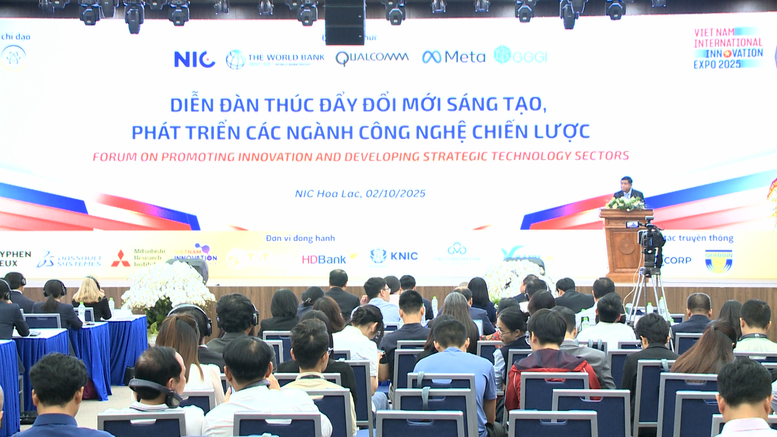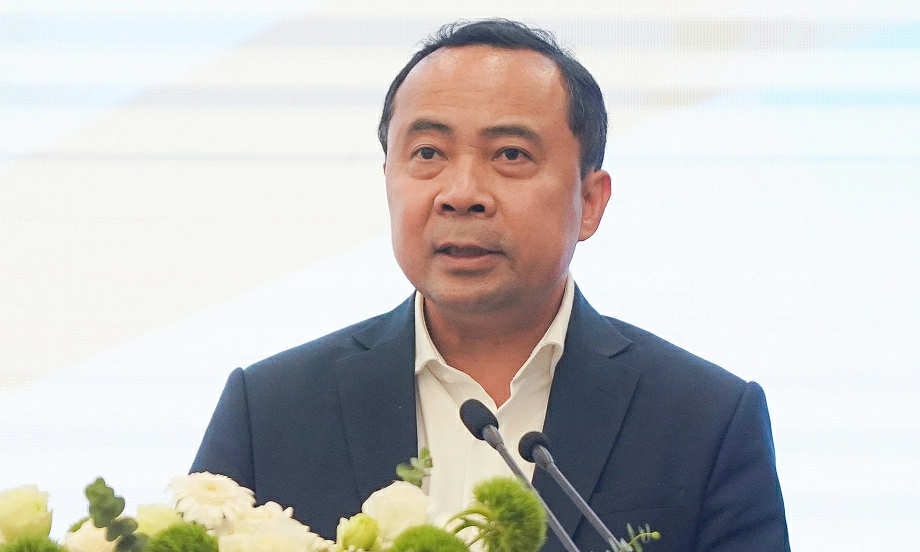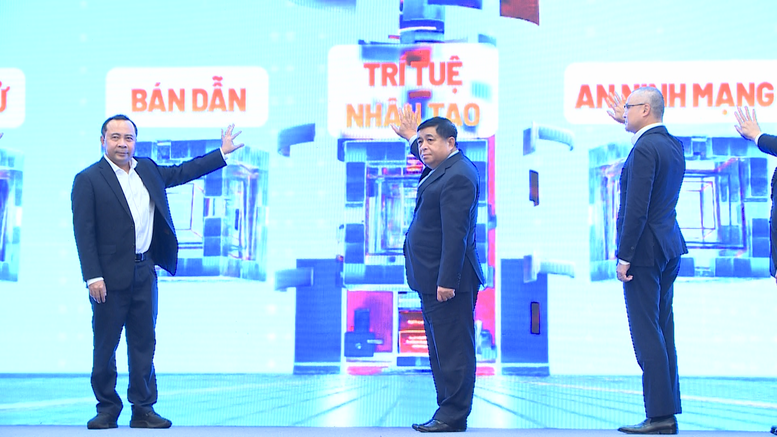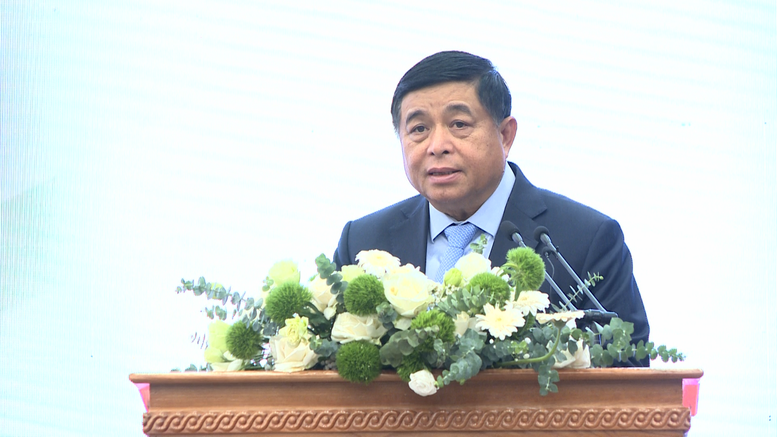Promoting innovation and developing strategic technology industries
In the context of a world marked by constant upheavals and intense geopolitical competition, especially in the field of technology, Vietnam has affirmed its strong commitment to making innovation and the development of strategic technology sectors a breakthrough focus for socio-economic development.

On October 2, 2025, as part of the National Innovation Day and Vietnam International Innovation Exhibition 2025, under the chairmanship of the Ministry of Finance, the National Innovation Center (NIC) collaborated with the World Bank, Qualcomm, Meta, and the Global Green Growth Institute (GGGI) in Vietnam to organize the Forum “Promoting Innovation and Developing Strategic Technology Industries.”
The forum was attended by Mr. Deputy Prime Minister Nguyễn Chí Dũng, Vice Chairman of the Government’s Steering Committee for Science, Technology, Innovation, and Digital Transformation, along with over 500 domestic and international delegates, including representatives from ministries, localities, leading technology corporations, businesses, international organizations, research institutes, universities, and experts from within and outside Vietnam.
Four directions for mastering strategic technologies
In his opening remarks, Deputy Minister of Finance, Mr. Nguyễn Đức Tâm emphasized the forum’s critical importance as an opportunity to exchange visions, share experiences, and reaffirm Vietnam’s commitment to prioritizing innovation and strategic technology industries into its socio-economic development strategy.
As the agency responsible for financial management, investment, and advising on socio-economic development, the Ministry of Finance affirmed its consistent stance that investing in innovation and strategic technologies is an investment in the nation’s future.
“We confirm to work with other ministries to advise the Government on improving mechanisms and policies to strongly encourage research, development, and commercialization of new technologies, while attracting resources and creating the most favorable conditions for technology companies and innovative startups,” Deputy Minister Nguyễn Đức Tâm emphasized.
Permanent Deputy Minister of Science and Technology, Mr. Vũ Hải Quân noted that technology is reshaping national strength and global value chains. Vietnam, therefore, needs a new approach to rise in the context of intense competition.
The Resolution 57 of the Politburo has identified bottlenecks and affirmed that Vietnam must master technology to achieve rapid, sustainable development while strengthening security and defense. In June, the Prime Minister issued a list of 11 strategic technology groups and 35 strategic product groups, such as AI, semiconductors, blockchain, and robotics, to promote the development of key industries.

To implement this quickly and effectively, the Ministry of Science and Technology has developed strategic technology programs in four directions:
First, standardize each strategic technology and product into foundational pillars, including core technology, infrastructure, and human resources.
Second, transform each pillar into standardized tasks, including context and objectives; scope and approach; implementation organization; products, timelines, and progress; budget and resources; and evaluation criteria.
Third, from these tasks, form project proposals to invite businesses, institutes, universities, ministries, and localities to participate.
Fourth, based on the implementation of strategic technologies and products, gradually build an innovation ecosystem.
The Ministry of Science and Technology hopes that experts, scientists, businesses, institutes, universities, and innovation alliances will provide recommendation on this implementation approach, Permanent Deputy Minister, Mr. Vũ Hải Quân shared at the forum.
Shaping the future of semiconductors
At the forum, the World Bank released the report “Shaping Vietnam’s Semiconductor Future: Breakthroughs from Technology Talent and Innovation” - the first in-depth World Bank report on talent and innovation for Vietnam’s semiconductor industry.
Speaking at the forum, Ms. Mariam J. Sherman, World Bank Country Director for Vietnam, Cambodia, and Laos, commended the Government’s commitment to leveraging science, technology, and innovation as a new growth driver. She noted that Vietnam has significant advantages, such as a young and talented workforce, a stable macroeconomic foundation, a strategic location, and proven adaptability.
According to Ms. Sherman, what is needed now is a comprehensive strategy - a “3+1” formula comprising technology talent, an innovation ecosystem, and supply chain integration, all linked by the “+1” factor: a strong focus on a few outstanding, selective innovation clusters.
The forum also witnessed specific commitments and initiatives from various components of the innovation ecosystem, clearly demonstrating the active participation of all stakeholders. Specifically, the World Bank released an in-depth report on Vietnam’s semiconductor industry. NIC and JICA, with strategic support from the Boston Consulting Group (BCG), announced the AI Startup Accelerator Program - VietLeap Accelerator 2025.
Additionally, leading global technology corporations like Qualcomm and Meta committed to promoting research and development (R&D) and supply chain development in Vietnam.
This is clear evidence of the engagement of all elements in the innovation ecosystem, from the government to businesses, institutes, universities, international organizations, and the technology startup community.
Notably, the forum also featured the announcement of initiatives to implement Resolution 57, initiated by NIC and 5 innovation networks and experts in the fields of artificial intelligence, semiconductors, cybersecurity, quantum technology, aerospace, and UAVs.

Japan’s Ambassador to Vietnam, Mr. Ito Naoki, expressed Japan’s commitment to being a reliable partner in innovation and education-training with Vietnam, particularly in AI and AI applications in socio-economic fields, all working together for Vietnam’s prosperity.
Six major trends impacting science, technology, innovation, and digital transformation
In his concluding remarks, Deputy Prime Minister Nguyễn Chí Dũng congratulated and highly appreciated the initiatives launched during the forum. The Party and State aim to place Vietnam among developed nations by 2045, but the challenge of the middle-income trap remains significant. To break through, Vietnam must take action to prove its ability to deeply participate in the global technology value chain.
In this context, Vietnam must move faster, seize opportunities, and be bolder, meaning that the country must chart its own path to shorten the gap with the international community.

Noting the rapidly evolving, complex, and unpredictable regional and global situation, Deputy Prime Minister Nguyễn Chí Dũng analyzed six major trends significantly impacting science, technology, innovation, and digital transformation:
First, increasing geopolitical competition, particularly U.S - China rivalry in shaping trends, standards, and rules for the new phase of the technology “game.”
Second, growing investment in science, technology, and innovation from both public and private sectors.
Third, AI’s rapid development and profound impact on the entire economy (from 2026-2030, AI is projected to create over 170 million new jobs and contribute approximately $5 trillion to the global economy, equivalent to about 13-14% of additional GDP for the period).
Fourth, science, technology, and innovation increasingly rely on ecosystem foundation, with close collaboration between governments, institutes, universities, large corporations, and startups.
Fifth, fierce competition for resources for science and technology development among nations, particularly in human resources, data, and computing capacity.
Sixth, governments are rapidly adjusting policies and promoting public-private partnerships to lead in science, technology, innovation, and digital transformation, especially in strategic industries like semiconductors and AI.
According to Mr. Deputy Prime Minister, General Secretary Tô Lâm has emphasized that science, technology, innovation, and digital transformation are the “golden key” and critical factors for Vietnam to overcome the middle-income trap and achieve its goal of becoming a developed nation by 2045. The draft documents for the 14th Party Congress also identify science, technology, and innovation as the “top priority breakthrough” and the “main driver” for the new development phase.
With the motto “to go fast, go alone; to go far, go together,” the Deputy Prime Minister noted that Vietnam must move faster, act more decisively, and be bolder to close the gap with the world while deeply integrating and strategically cooperating with leading economies, reputable international organizations, and technology corporations. Only by leveraging intelligence, resources, technology, and global cooperation networks can Vietnam accelerate development and gradually assert its position on the global technology map.
To develop Vietnam’s innovation ecosystem and realize the aspiration of becoming a leading science, technology, and innovation hub, the Deputy Prime Minister called on all levels, sectors, localities, top Vietnamese and Vietnamese-origin experts, technology corporations, and international organizations to collaborate, leverage technology, propose strategies, and develop roadmaps for industries while synchronizing policy documents. Innovation networks should serve as the “extended arm” of the Government, creating new value and opportunities for the future.
With the highest political determination, the aspiration to rise, and the support and collaboration of the international community, Vietnam will turn its aspirations into reality, gradually transforming into an independent, self-reliant nation that spreads the spirit of innovation and rises strongly, the Deputy Prime Minister emphasized.
---
Translation copyright belongs to Vietnam Journal of Science and Technology (VJST).

